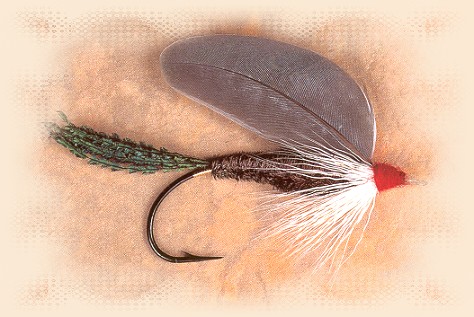Dr. James A. Henshall, better known as the "apostle of the black bass"
and best known as the author of The Book of the Black Bass,
was the originator of the fly that bears his name.
James Henshall, sometimes referred to as the dean of American
anglers, was born in Baltimore, Maryland, in 1836 and died in
Cincinnati, Ohio in 1925. After receiving his degree of Doctor
of Medicine, he continued actively in the practice until about
1885.
His first edition of The Book of the Black Bass was
published in 1881. In 1892 Mr. Henshall was president of the Ohio
State Fame and Fish Commission.
When he gave up the practice of medicine for fishing and angling
and the sciences connected therewith, he was put in charge of the
Bozeman, Montana, station of the United States Bureau of Fisheries,
where he remained from 1896 to 1909.
While his favorite fish was the bass, he did a great deal of
experimental work with propagation of the grayling. In 1909
he took over the operation of the United States Hatchery at Tupelo,
Mississippi, where his favorite game fish, the black bass, were
reared. There he stayed until 1917, when he retired because of
failing eyesight.
In 1891 he served as president of the American Fisheries Society.
Soon after its formation he was made an honorary president of the
Izaak Walton League of America. He was in charge of the fisheries
exhibition at the World's Fair in Chicago in 1893 and there, with
W.C. Harris and H.L. Stanton, judged the first "Open to the World"
Championship Casting Tournament put on at the Fair by the Chicago
Fly Casting Club.
When the National Rod and Reel Association was about to hold its 1883
tournament in Central Park, New York City, Dr. J.A. Henshall was
anxious to have a contest in bait casting from the reel, and
formulated a set of rules for it and sent them to the secretary
of the association. They were not adopted, one reason being
there would have been no entries, because the "Henshall style"
was not practiced in the East at that time.
Dr. Henshall got his way the next year and bait casting, as we now
know it, made its appearance as "minnow casting."
Dr. Henshall himself describes his bass fly as: body, peacock
herl: hackle white hairs from deer's tail; wings, gray (dove);
tail, two fibres (green) from peacock's feathers.
It was Dr. Henshall who wrote, "Fly fishing is, indeed, the
poetry of angling.
The Golden Dustman, Polka, Oriole [Lord Baltimore] and Oconomowoc
are also his designs. The Doctor has, for a time, lived in and
been Mayor of Oconomowac, Wisconsin.
Henshall
Head: Red wool.
Tail: Peacock sword.
Body: Peacock herl.
Wing: Pale blue body feather (original called for gray dove).
Hackle: White or pearl gray.
Credits: Information from Fly Patterns and Their Origins,
by Harold Hinsdill Smedley, published by Westshore Publications.
Photo from Forgotten Flies published by Complete
Sportsman. ~ DLB
|

